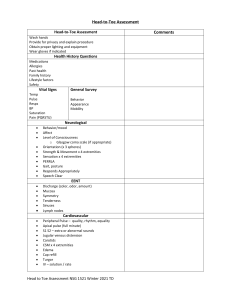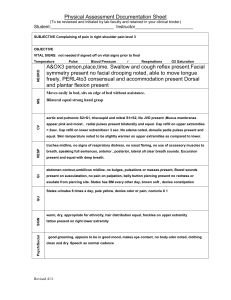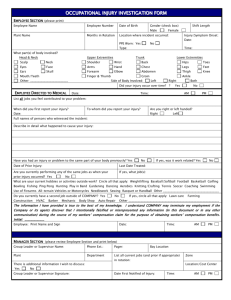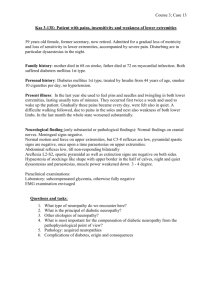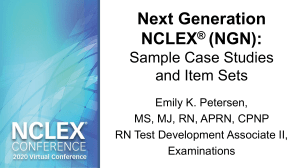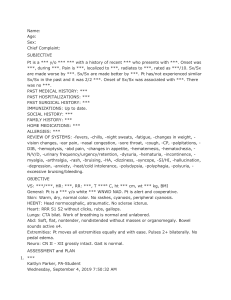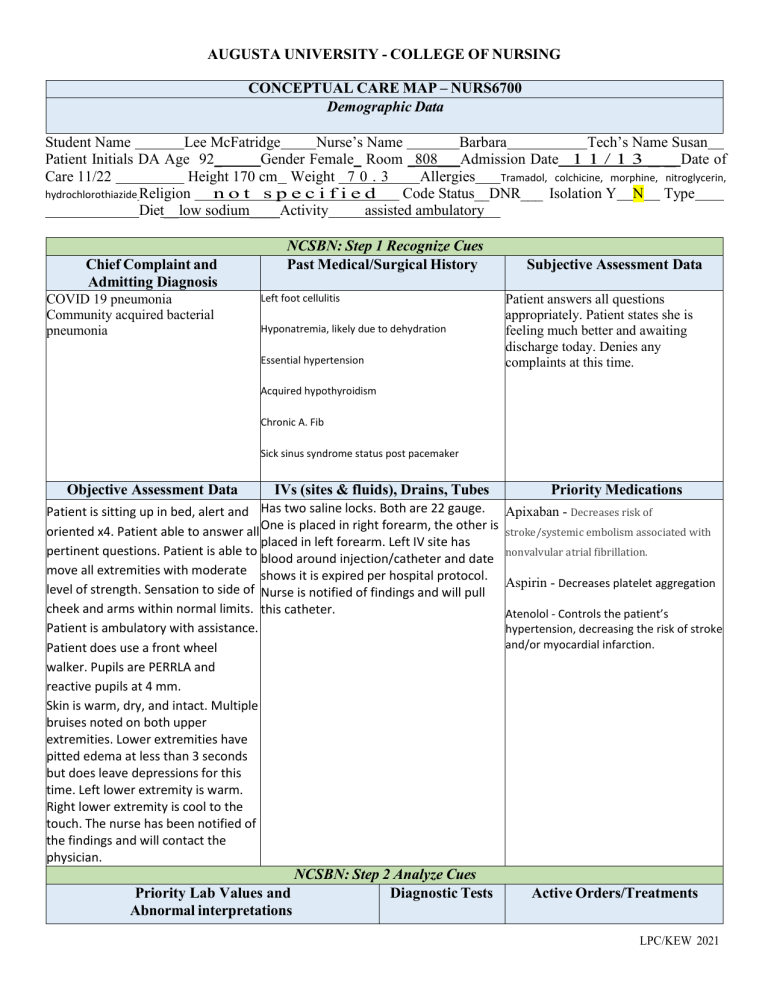
AUGUSTA UNIVERSITY - COLLEGE OF NURSING CONCEPTUAL CARE MAP – NURS6700 Demographic Data Student Name Lee McFatridge Nurse’s Name Barbara Tech’s Name Susan Patient Initials DA Age 92_ Gender Female_ Room _808___Admission Date 1 1 / 1 3 _ _ Date of Care 11/22 Height 170 cm Weight 7 0 . 3 Allergies Tramadol, colchicine, morphine, nitroglycerin, hydrochlorothiazide Religion not specified Code Status__DNR___ Isolation Y N Type Diet__low sodium____Activity assisted ambulatory Chief Complaint and Admitting Diagnosis COVID 19 pneumonia Community acquired bacterial pneumonia NCSBN: Step 1 Recognize Cues Past Medical/Surgical History Left foot cellulitis Hyponatremia, likely due to dehydration Essential hypertension Subjective Assessment Data Patient answers all questions appropriately. Patient states she is feeling much better and awaiting discharge today. Denies any complaints at this time. Acquired hypothyroidism Chronic A. Fib Sick sinus syndrome status post pacemaker Objective Assessment Data IVs (sites & fluids), Drains, Tubes Patient is sitting up in bed, alert and Has two saline locks. Both are 22 gauge. oriented x4. Patient able to answer all One is placed in right forearm, the other is placed in left forearm. Left IV site has pertinent questions. Patient is able to blood around injection/catheter and date move all extremities with moderate shows it is expired per hospital protocol. level of strength. Sensation to side of Nurse is notified of findings and will pull cheek and arms within normal limits. this catheter. Patient is ambulatory with assistance. Patient does use a front wheel walker. Pupils are PERRLA and reactive pupils at 4 mm. Skin is warm, dry, and intact. Multiple bruises noted on both upper extremities. Lower extremities have pitted edema at less than 3 seconds but does leave depressions for this time. Left lower extremity is warm. Right lower extremity is cool to the touch. The nurse has been notified of the findings and will contact the physician. NCSBN: Step 2 Analyze Cues Diagnostic Tests Priority Lab Values and Abnormal interpretations Priority Medications Apixaban - Decreases risk of stroke/systemic embolism associated with nonvalvular atrial fibrillation. Aspirin - Decreases platelet aggregation Atenolol - Controls the patient’s hypertension, decreasing the risk of stroke and/or myocardial infarction. Active Orders/Treatments LPC/KEW 2021 See attached lab values. Many listed outside of normal limits. Patient has several abnormal lab values that show possible liver issues. Lab values should be Patient is being discharged with rechecked due to medication list. Further evaluation of abnormalities from abnormal lab values is indicated. yesterday. CONCEPTUAL CARE MAP - NURS 6700 NCSBN: Step 3 Prioritize Hypotheses Priority Nursing Diagnosis…Related To…As Evidenced By… Activity Intolerance/Impaired Mobility related to patient having increased age, cardiac issues, and cellulitis in lower extremities. Patient can ambulate but needs assistance in and out of bed in order to get to walker. Supporting Subjective Data Supporting Objective Data Patient states although she can walk, she will need assistance Multiple bruises noted on both upper extremities possibly getting out of bed and near her walker. She states she does due to bumping into objects. Lower extremities have pitted become tired often while walking. edema at less than 3 seconds but does leave depressions for this time. Left lower extremity is warm. Right lower extremity is cool to the touch. Primary Outcome: Client Will… (Must be patient-Specific, Measurable, Attainable, Relevant to nursing diagnosis, Time-specific--SMART) Patient should be educated on the proper use of the walker and when/how to know when to rest when using. Mobility and activity will be maintained at an optimal level for patient. Assess and monitor patient barriers to mobility and need for assistive/adaptive devices. Assess patient's emotional response to limitations. Collaborate with interdisciplinary team and initiate plans and interventions as ordered. Patient will walk some today taking breaks as needed to strengthen and provide needed stamina. Assessment NCSBN: Step 4 Generate Solutions/Step 5 Take Action Priority Interventions (Rationale) Treatment and Medication(s) Patient and Family Education Patient does have cellulitis and states it Patient is on nonopioid analgesics and is difficult to move lower extremities for uses assistive devices for ambulation. longer lengths of time. Assessment for patient long and short term pain goals should be attempted with patient. Goal is for patient to be more mobile/ambulatory. Patient should be educated on walk/rest procedures to keep from becoming tired and also to maintain absent pain or controlled at a level of 4 or less. NCSBN: Step 6 Evaluate Outcomes LPC/KEW 2021 Evaluation: What is the overall status of client? Focus on the priority nursing diagnosis, describe the patient’s status; improved? declined? unchanged? during your shift; provide supporting evidence. Patient has improved since her hospital admission. With the pneumonia symptoms alleviated, patient is stronger and more able to ambulate. However, the time bedridden from the infection has left her tired and some atrophy might be noted. Patient is able to leave bed by herself and was assisted to the bathroom. Patient was willing to bathe herself with little assistance. The patient understands and wants to be more mobile while decreasing any pain/neuropathy she might be experiencing. References Piedmont EMR/EPIC NANDA LPC/KEW 2021

